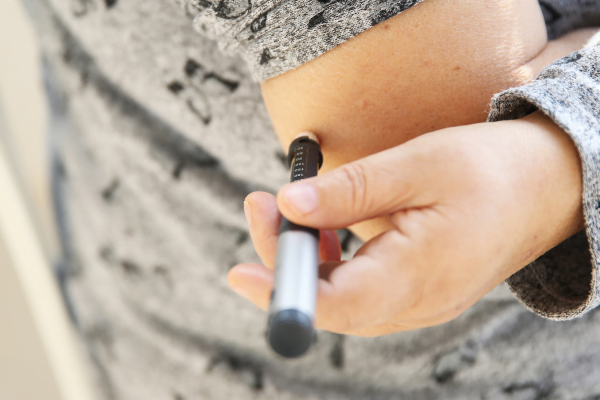Adlyxin is a once-daily glucagon-like peptide-1 receptor agonist used for adults with type 2 diabetes. This guide explains how lixisenatide works, how to use the pen correctly, and how to discuss risks and alternatives with your care team.
Key Takeaways
- Once-daily GLP-1 option that helps lower post-meal glucose.
- Start low and titrate to reduce nausea and vomiting risk.
- Use the prefilled pen correctly to avoid missed or extra doses.
- Watch for hypoglycemia with insulin or sulfonylureas.
- Compare alternatives by goals, device comfort, and tolerability.
What Is adlyxin and How It Works
Lixisenatide activates the GLP-1 receptor to enhance glucose-dependent insulin release. It slows gastric emptying and suppresses post-meal glucagon. These combined effects help reduce after-meal blood sugar spikes, which often drive elevated A1C.
Unlike basal insulin, a GLP-1 RA works only when glucose is elevated, which may lower hypoglycemia risk when used alone. Class education helps set expectations on benefits and tolerability. For a class overview with examples, see GLP-1 Receptor Agonists for mechanism and drug list context.
Indications and Patient Selection
Lixisenatide is indicated as an adjunct to diet and exercise in adults with type 2 diabetes. It can be used alone or with other agents such as metformin or basal insulin. People with prominent postprandial hyperglycemia, high A1C driven by after-meal spikes, or intolerance to other therapies may be candidates.
Consider renal function, gastrointestinal tolerance, and prior pancreatitis history before initiating therapy. When comparing Type 2 Diabetes treatment frameworks, device familiarity and dosing schedule often shape adherence. Within the broader landscape of glp-1 drugs, individual goals, comorbidities, and cost-sharing drive selection.
Dosing and Titration
Standard initiation uses a low dose for one to two weeks, followed by a maintenance dose if tolerated. Titration aims to balance glucose lowering with gastrointestinal comfort. Patients should inject on the same schedule each day, preferably within an hour before the first main meal.
When nausea occurs during up-titration, consider lengthening the lower-dose period. Avoid dose changes without clinical guidance. Do not mix with insulin in the same syringe or pen. If you previously used exenatide twice-daily or byetta, confirm the new timing and device steps carefully during the switch.
| Week | Typical Approach |
|---|---|
| 1–2 | Start low; monitor for GI symptoms |
| 3+ | Advance to maintenance if tolerated |
Special Populations and Renal Impairment
Because lixisenatide is cleared primarily by the kidneys, impaired renal function can increase exposure. Assess baseline eGFR and monitor periodically if function is borderline or declining. Dose adjustments, slower titration, or alternative therapies may be prudent in moderate to severe impairment. Report reduced urine output, swelling, or unexpected fatigue promptly. Older adults may be more sensitive to GI effects and dehydration risks. Coordinate with prescribers to adjust concomitant sulfonylureas or basal insulin to mitigate hypoglycemia during initiation and titration.
How to Use the Prefilled Pen
Review the device steps before the first injection. Prime according to the manufacturer’s instructions, attach a new needle each time, and inject into the subcutaneous tissue of the abdomen, thigh, or upper arm. Rotate sites to reduce lipodystrophy. Wait the specified seconds before removing the needle to ensure full dose delivery.
Store unused pens in the refrigerator and the in-use pen at recommended room temperature away from heat and light. Never reuse needles. For additional device context with fixed-ratio combinations, see Soliqua SoloStar Pen for co-formulation handling and dose coupling considerations.
Safety Profile and Side Effects
The most common reactions involve the gastrointestinal tract, including nausea, vomiting, and diarrhea. These usually lessen with time and slower titration. Hydration and smaller meals can help. Be alert for signs of pancreatitis such as persistent severe abdominal pain, which requires prompt evaluation. For authoritative safety details, review the FDA prescribing information before starting therapy or combining with insulin.
Hypoglycemia risk increases when used with sulfonylureas or basal insulin; dose adjustments of those agents may be needed. Rare events include allergic reactions and kidney issues from severe vomiting or dehydration. As with other glp-1 side effects, counsel on gradual titration and when to seek care. Professional guidelines in the ADA Standards of Care summarize class warnings and patient monitoring points.
Weight and Cardiometabolic Effects
Lixisenatide may support modest weight reduction for some people, largely by reducing appetite and slowing gastric emptying. Weight response varies due to diet, physical activity, and concurrent medications. Avoid assuming a specific number on the scale. Track waist, energy level, and glycemic trends to see overall benefit.
For individuals exploring glp-1 for weight loss, align expectations with diabetes control first, then reassess weight goals. Class data highlight varying effects across agents. For broader context on evidence and public health signals, see GLP-1 Weight Loss Drugs to compare weight trends and mechanisms.
Comparisons and Combinations
Within GLP-1 options, device format, frequency, and tolerability differ. Weekly injectables may suit some users; others prefer simple daily routines. Fixed-ratio combinations pair a GLP-1 RA with basal insulin for stronger A1C reduction when monotherapy is not enough. Lixisenatide is co-formulated with insulin glargine in Soliqua for once-daily use.
When considering soliqua, discuss goals, hypoglycemia risk, and injection readiness. For a comparison of emerging oral alternatives, see Orforglipron vs. Rybelsus for efficacy and adherence considerations. If you need product specifics for fixed-ratio pens, review Soliqua 100/33 Pens for formulation and device parameters. Avoid stacking therapies with overlapping mechanisms without coordinated supervision.
Practical Storage, Travel, and Monitoring
Keep unused pens refrigerated and avoid freezing. In-use pens can stay at recommended room temperature according to labeling. For long trips, use an insulated case and keep the device out of direct sunlight. Build a checklist with needles, alcohol swabs, and a sharps container. For travel-specific tips on temperature and timing, see Travel With Ozempic for storage thresholds and dose timing under transit constraints.
Routine monitoring includes fasting and post-meal glucose, A1C every three months, and symptom checks for dehydration or GI intolerance. Patients often ask trulicity vs ozempic when weighing weekly options, but device preferences and side effect profiles drive the choice. For duration considerations, see How Long to Take Ozempic for discussion on persistence and reassessment points. For broader pharmacology context, review Common Diabetes Medications to map where injectables fit with oral agents.
When to Escalate or Switch
Reassess therapy when A1C remains above target, symptomatic hypoglycemia occurs, or GI effects persist despite dose adjustments. If kidney function declines or pancreatitis is suspected, hold the drug and evaluate alternatives. Consider fixed-ratio combinations, weekly GLP-1 agents, or SGLT2 inhibitors depending on cardiometabolic profile and renal status.
Shared decision-making should prioritize goals, adverse-event tolerance, and device comfort. For structured comparisons across drug classes, see Oral Antidiabetic Drugs for metformin and SGLT2 context, and Common Diabetes Medications for therapeutic sequencing. Tip: Bring recent glucose logs and your device to each visit to streamline adjustments.
Recap
Lixisenatide helps reduce post-meal glucose when added to individualized treatment plans. Start with a low dose, titrate carefully, and use the prefilled pen as instructed. Monitor for GI symptoms and hypoglycemia, especially with insulin or sulfonylureas. Compare alternatives by goals, device fit, and tolerability, then reassess regularly.
For more on GLP-1 mechanisms and drug families, see GLP-1 Receptor Agonists for class-wide insights that support informed decisions. Note: Cross-check any new symptoms against official labeling before continuing therapy.
This content is for informational purposes only and is not a substitute for professional medical advice.



